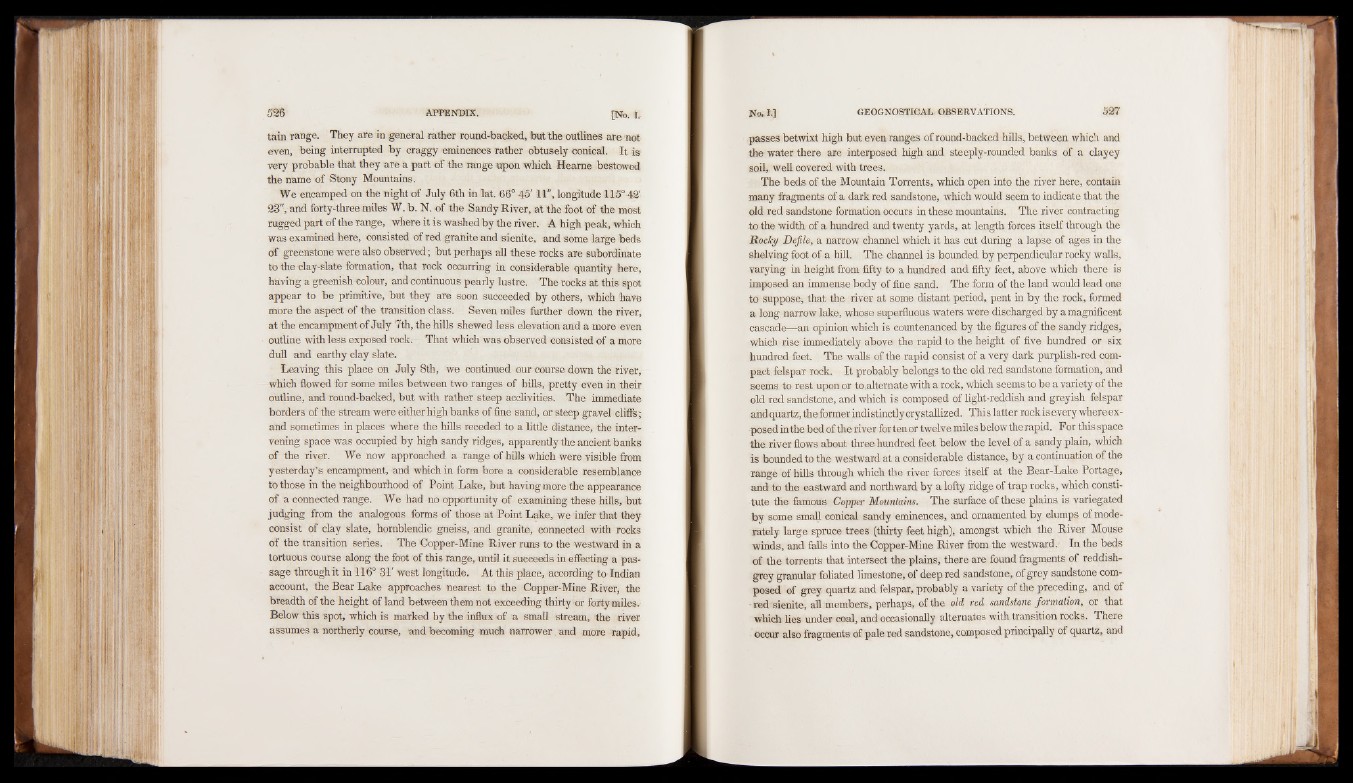
tain range. They are in general rather round-backed, but the outlines are not
even, being interrupted by craggy eminences rather obtusely conical. It is
very probable that they are a part of the range upon which Hearne bestowed
the name of Stony Mountains.
We encamped on the night of July 6th in lat. 66° 45' 11", longitude 115° 42'
23'', and forty-three miles W. b. N. of the Sandy River, at the foot of the most
rugged part of the range, where it is washed by the river. A high peak, which
was examined here, consisted of red granite and sienite, and some large beds
of greenstone were also observed; but perhaps all these rocks are subordinate
to the clay-slate formation, that rock occurring in considerable quantity here,
having a greenish colour, and continuous pearly lustre. The rocks at this spot
appear to be primitive, but they are soon succeeded by others, which have
more the aspect of the transition class. Seven miles further down the river,
at the encampment of July 7th, the hills shewed less elevation and a more even
outline with less exposed rock. That which was observed consisted of a more
dull and earthy clay slate.
Leaving this place on July 8th, we continued our course down the river,
which flowed for some miles between two ranges of hills, pretty even in their
outline, and round-backed, but with rather steep acclivities. The immediate
borders of the stream were either high banks of fine sand, or steep gravel cliffs;
and sometimes in places where the hills receded to a little distance, the intervening
space was occupied by high sandy ridges, apparently the ancient banks
of the river. We now approached a range of hills which were visible from
yesterday’s encampment, and which in form bore a considerable resemblance
to those in the neighbourhood of Point Lake, but having more the appearance
of a connected range. We had no opportunity of examining these hills, but
judging from the analogous forms of those at Point Lake, we infer that they
consist of clay slate, hornblendic gneiss, and granite, connected with rooks
of the transition series. The Copper-Mine River runs to the westward in a
tortuous course along the foot of this range, until it succeeds in effecting a passage
thrcughft in 116° 31' west longitude. At this place, according to 'Indian
account, the Bear Lake approaches nearest to the Copper-Mine River, the
breadth of the height of land between them not exceeding thirty or forty miles.
Below this spot, which is marked by the influx of a small stream, the river
assumes a northerly course, and becoming much narrower and more rapid,
passes betwixt high but even ranges of round-backed hills, between which and
the water there are interposed high and steeply-rounded banks of a clayey
soil, well covered with trees.
The beds of the Mountain Torrents, which open into the river here, contain
many fragments of a dark red sandstone, which would seem to indicate that the
old red sandstone formation occurs in these mountains. The river contracting
to the width of a hundred and twenty yards, at length forces itself through the
Roc/cy Defile, a narrow channel which it has cut during a lapse of ages in the
shelving foot of a hill. The channel is bounded by perpendicular rocky walls,
varying in height from fifty to a hundred and fifty feet, above which there is
imposed an immense body of fine sand. The form of the land would lead one
to suppose, that the river at some distant period, pent in by the rock, formed
a long narrow lake, whose superfluous waters were discharged by a magnificent
cascade—an opinion which is countenanced by the figures of the sandy ridges,
which rise immediately above the rapid to the height of five hundred or six
hundred feet. The walls of the rapid consist of a very dark purplish-red compact
felspar rock. It probably belongs to the old red sandstone formation, and
seems to rest upon or to .alternate with a rock, which seems to be a variety of the
old red sandstone, and which is composed of light-reddish and greyish felspar
and quartz, the former indistinctly crystallized. This latter rockisevery whereex-
posedinthe bed of the river fortenor twelve miles belowthe rapid. For this space
the river flows about three hundred feet below the level of a sandy plain, which
is bounded to the westward at a considerable distance, by a continuation of the
range of hills through which the river forces itself at the Bear-Lake Portage,
and to the eastward and northward by a lofty ridge of trap rocks, which constitute
the famous Copper Mountains. The surface of these plains is variegated
by some small conical sandy eminences, and ornamented by clumps of moderately
large spruce trees (thirty feet high), amongst which the River Mouse
winds, and falls into the Copper-Mine River from the westward. In the beds
of the torrents that intersect the plains, there are found fragments of reddish-
grey granular foliated limestone, of deep red sandstone, of grey sandstone composed
of grey quartz and felspar, probably a variety of the preceding, and of
- red sienite, all members, perhaps, of the old red sandstone formation, or that
which lies under coal, and occasionally alternates with, transition rocks, There
occur also fragments Of pale red sandstone, composed principally of quartz, and